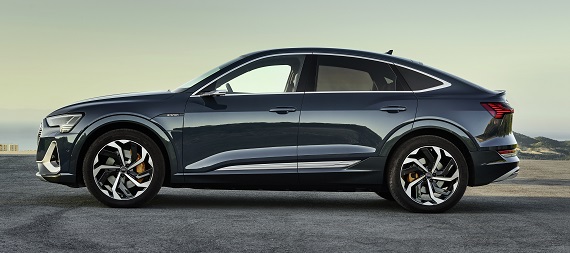

Coupe, SUV, 5 Doors, 5 Seats
200 km/h 124.27 mph
Electric,
All wheel drive (4x4),
4901 mm
192.95 in.
1935 mm
76.18 in.
#N/D
| Brand | Audi |
|---|---|
| Model | E-tron (Coupe, SUV) |
| Version | E-tron Sportback |
| Engine version | 55 95 kWh (408 Hp) quattro |
| Year production start | 2020 |
| Vehicle type | Coupe, SUV |
| Acceleration 0 - 100 kmh sec | 5.7 sec |
| Overall length mm - inch |
4901 mm192.95 in. |
| Doors | 5 |
| Top Speed | 200 km/h 124.27 mph |
| Engine position and orientation | Front axle, Transverse |
|---|---|
| Cylinders | Electric |
| Fuel type | Electricity |
| Powertrain architecture | BEV (Electric Vehicle) |
| Total available power | 408 Hp |
| Totale available torque | 664 Nm 489.74 lb.-ft. |
| Drive configuration | All wheel drive (4x4) |
|---|
| Front suspension | Multi-link suspension |
|---|---|
| Rear suspension | Multi-link independent |
| Wheels size | 255/55 R19 |
|---|---|
| Wheels rims | 19 |
| Passengers seats | 5 |
|---|---|
| Trunk space min liter | cu. Ft. |
615 l21.72 cu. ft. |
| Trunk space max liter | cu. Ft. |
1655 l58.45 cu. ft. |
| Overall length mm - inch |
4901 mm192.95 in. |
|---|---|
| Overall width mm -inch |
1935 mm76.18 in. |
| Overall height mm -inch |
1616 mm63.62 in. |
| Wheelbase mm - inch |
2928 mm115.28 in. |
| Track width front mm - inch |
1655 mm65.16 in. |
| Track width rear mm - inch |
1655 mm65.16 in. |
| Coefficient of drag | 0.25 |
Electric
Electric - Bev
A battery-powered electric car is an automobile which is propelled by electric motors.
Although electric cars often give good acceleration and have generally acceptable
top speed, the lower specific energy of production batteries available compared
with carbon-based fuels means that electric cars need big batteries to
increase miles range and recharging can also take much more time than average.
Electric - PHEV
A plug-in hybrid electric vehicle (PHEV) is a hybrid electric vehicle whose battery
pack can be recharged by plugging a charging cable into an external electric power
source, in addition to internally by its on-board internal combustion engine-powered
generator. Compared to conventional hybrid electric vehicles (HEVs), PHEVs have
a larger battery pack that can be charged from the power grid, which is also more
efficient.
A PHEV's battery pack is smaller than all-electric vehicles for the same vehicle
weight, but has the auxiliary option of switching back to using its gasoline/diesel
engine like a conventional HEV if the battery runs low.
Electric - FCEV
A fuel cell electric vehicle (FCEV) is an electric vehicle that uses a fuel cell,
sometimes in combination with a small battery or supercapacitor, to power its
onboard electric motor. Fuel cells in vehicles generate electricity generally
using oxygen from the air and compressed hydrogen. Most fuel cell vehicles are
classified as zero-emissions vehicles that emit only water and heat.
As compared with internal combustion vehicles, hydrogen vehicles centralize pollutants at
the site of the hydrogen production, where hydrogen is typically derived from
reformed natural gas.
Electric - PFCEV
This vehicle is very similar to Fuel Cell Electric Vehicle but has a socket and
can be recharged from the grid. Battery likely is significantly larger - comparable to
Plug in Hybrid Electric Vehicle. This vehicle type can be used solely on electricity
charged by plugging in or solely on electricity generated by fuel cell.
Plug-in fuel cell electric vehicles (PFCEVs) combine features of battery electric
vehicles (BEVs) and fuel cell electric vehicles (FCEVs). With a 40-mile battery
electric range (BER), the PFCEV provides unusually efficient driving.
The fuel cell and hydrogen fuel facilitate long range and quick refueling, removing range
limitations.
Source:
https://en.wikipedia.org/wiki/Battery_electric_vehicle
https://en.wikipedia.org/wiki/Plug-in_hybrid
https://en.wikipedia.org/wiki/Vehicle_classification_by_propulsion_system
https://escholarship.org/uc/item/57h0j2sv
edited by arrabbiata
https://www.thecarspec.com/components/engine/electric